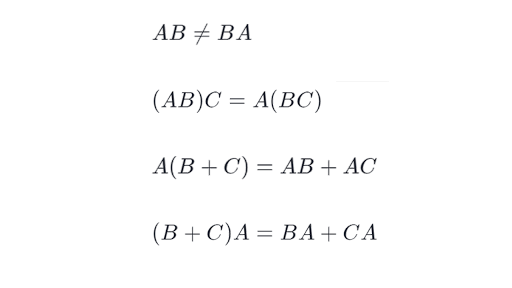Matrix Multiplication And Addition Rules
2 Laws of Matrix Arithmetic Many of the standard rules from ordinary arithmetic carry over into matrix arithmetic. Some of these are1 ABBA cABcAcB ABCABC CAB CACB ABCACBC ABC ABC Perhaps the most interesting and unexpected of the above rules is ABG ABC.
Matrix Multiplication Made Easy
The most important rule to know is that when adding two or more matrices first make sure the matrices have the same dimensions.
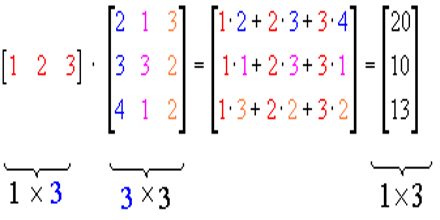
Matrix multiplication and addition rules. Scalar by a matrix by multiplying every entry of the matrix by the scalar this is denoted by juxtaposition or with the scalar on the left. However you cannot add a 3 x 2 with a 2 x 3 or a 2 x 2 with a 3 x 3. 2 1 6 9 3 6 0 2 12 18 6 12 0 sometimes you see scalar multiplication with the scalar on the right.
The Subtraction are performed only those two Matrices which have same order. The row-column rule for matrix multiplication. 9 2 10 5 1 perform multiplication 18 10 5 1 perform division 18 2 1 perform subtraction 16 1 perform addition 17.
Now as per the rules of laws of matrices. Rules of those operations of Matrix - The Addition are performed only those two Matrices which have same order. The dimensions of the input matrices should be the same.
AB BA Commutative Law of Addition. Mtimes Matrix left division. We call this associativity and that matrix multiplication.
Let us consider A B and C are three different square matrices. If you wish to perform element-wise matrix multiplication then use npmultiply function. We can multiply a number aka.
Lets look at each operation separately to see how that works. A is the transpose and A -1 is the inverse of A. And if you have to compute matrix product of two given arraysmatrices then use npmatmul function.
The number of columns of A must equal the number of rows of B. Then perform addition and subtraction from left to right. In order words you can add a 2 x 3 with a 2 x 3 or a 2 x 2 with a 2 x 2.
Calculate 9 2 10 5 1 Solution. The Multiplication are performed on Matrices if and only if the column of. Numpy offers a wide range of functions for performing matrix multiplication.
Then the ij entry of C is the i th row of A times the j th column of B. Let A be an m n matrix let B be an n p matrix and let C AB. Multiplication of matrices is associative ie.
For example the addition of two given matrices with dimension 2 2. Here is a diagram. The algebra of matrix follows some rules for addition and multiplication.
Multiplication of matrices is distributive with respect to addition ie if matrices A B and C are compatible for the requisite addition and multiplication then A. If matrices A B and C are conformable for multiplication then ABC A BC. I is the identity matrix and R is a real number.
C ij a i 1 b 1 j a i 2 b 2 j a in b nj. First perform the multiplication and division from left to right. C AB is the linear algebraic product of the matrices A and B.
Adding and subtracting matrices and multiplying a matrix by a constant When multiplying a matrix by a scalar a constant or number or adding and subtracting matrices the operations are done entry by entry.
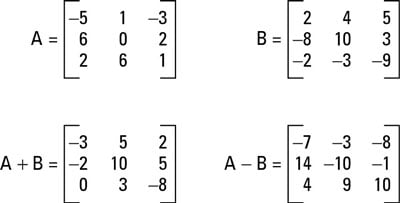
How To Apply Basic Operations To Matrices Dummies

Adding And Subtracting Matrices And Multiplying A Matrix By A Constant Mathbootcamps

3 4a Matrix Operations Finite Math

3 4a Matrix Operations Finite Math
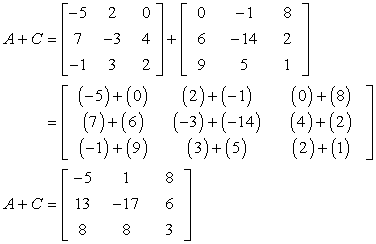
Adding And Subtracting Matrices Chilimath
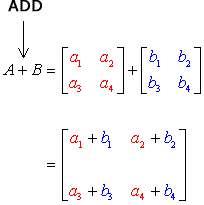
Adding And Subtracting Matrices Chilimath

Matrix Operations Assignment Point

Adding And Subtracting Matrices And Multiplying A Matrix By A Constant Mathbootcamps
Multiplying Matrices Article Matrices Khan Academy
Matrix Addition Subtraction Article Khan Academy

Matrices Adding Multiplying Gaussian Elimination Cramer S Rule 3x3 Matrix Youtube

How To Multiply Matrices Quick Easy Youtube

Adding And Subtracting Matrices And Multiplying A Matrix By A Constant Mathbootcamps

How To Add And Subtract Matrices Studypug

7 1 Matrices Vectors Addition And Scalar Multiplication
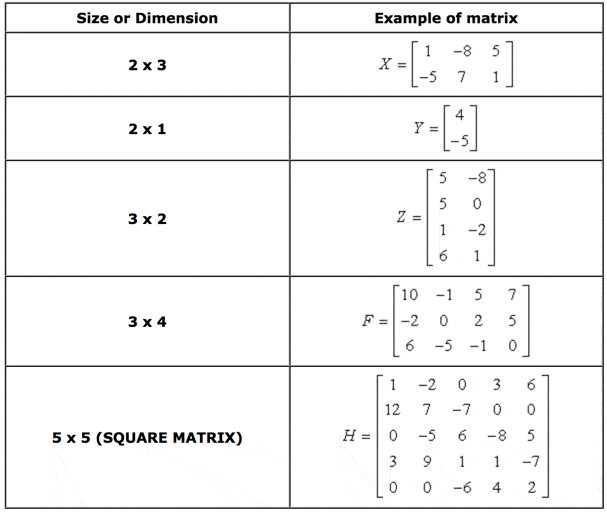
Adding And Subtracting Matrices Chilimath
Properties Of Matrix Multiplication Article Khan Academy

3 4a Matrix Operations Finite Math



